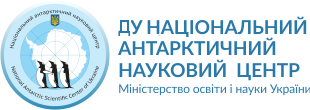Відділ біології і екології
Напрями досліджень
Відділ займається низкою досліджень в галузі полярної біології і екології, а також вивченням організмів в екстремальних умовах довкілля. Робота відділу охоплює такі основні напрями, як морська біологія, екологія наземних екосистем, біопроспектінг та охорона природи.
Зокрема, проводяться такі дослідження:
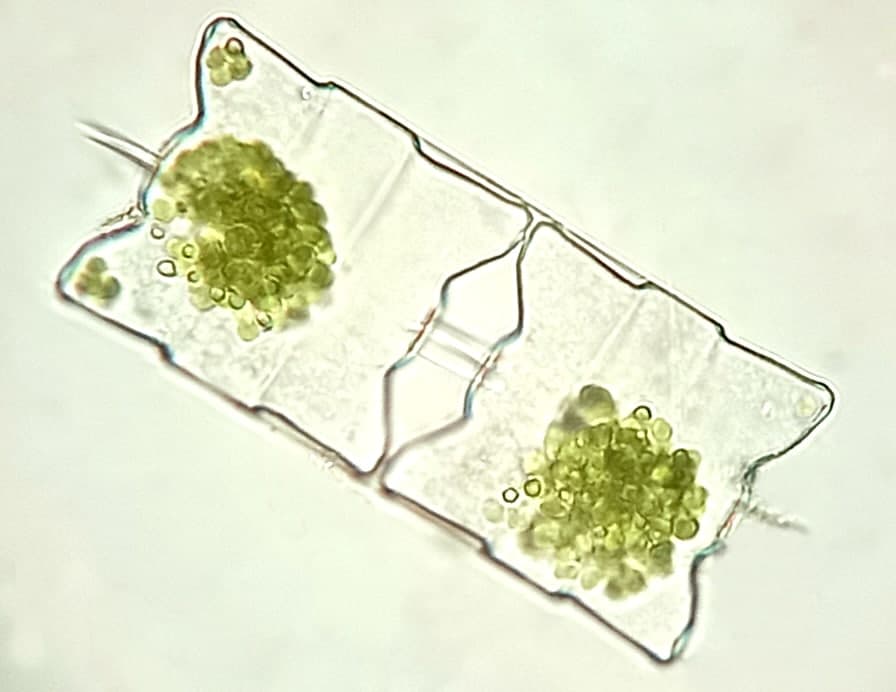
1.1 Дослідження різноманіття, динаміки та взаємодії угруповань фіто- та бактеріопланктону в умовах глобальних змін в регіоні морської Антарктики
Угруповання морського фіто- та бактеріопланктону мають високу чисельність та колосальне генетичне різноманіття. Вони є ключовими гравцями у збереженні балансу між фіксацією та продукцією CO2 та суттєво впливають на біогеохімічні цикли інших елементів (N, S, Fe). Вивчення взаємозв’язку між бактеріопланктоном та фітопланктоном є фундаментальним напрямом досліджень. Ця взаємодія впливає на колообіг поживних речовин і регулює продуктивність та стабільність морських екосистем, а також вуглецевий баланс між океаном та атмосферою. Зокрема, це суттєво для регіону морської Антарктики, де темпи змін клімату є найбільш відчутними, а зміни в продуктивності морського планктону безпосередньо впливають на інших антарктичних мешканців (морські ссавці та птахи, бентосні угруповання, наземні угруповання).
2019 року на станції “Академік Вернадський” було започатковано моніторинг динаміки та взаємодії угруповань фіто- та бактеріопланктону. Дослідження включає аналіз таксономічного та функціонального різноманіття бактеріо- та фітопланктону, факторів, що регулюють їхню річну та сезонну динаміку, а також адаптацій цих угруповань до умов морської Антарктики. Дослідження відповідає пріоритетам SCAR і знаходиться в руслі програм AntEco, AnT-ERA та AntClimnow.
1.2 Оцінка поточного стану та динаміки угруповань морських ссавців Західної Антарктики
Морські ссавці є едифікаторами морських екосистем і важливими індикаторами їхнього стану. Вивчення цих хижаків найвищого рівня у морських екосистемах Південного океану є одним з пріоритетних завдань біологічних досліджень в регіоні. В ХХ столітті популяції китоподібних в Південному океані активно експлуатувалися в ході комерційного китобійного промислу, що призвело до критичного скорочення їхньої чисельності та перерозподілу видів у водах Західної Антарктики.
Одним із напрямів наших досліджень з 2018 року є оцінка поточного стану і динаміки угруповань морських ссавців Західної Антарктики в умовах інтенсивних кліматичних змін. За допомогою цілорічних спостережень із застосуванням методів фотоідентифікації, а також молекулярно-генетичних і акустичних методів, виконуються комплексні дослідження структури популяцій, розмноження та харчової поведінки морських ссавців.
Здійснюється вивчення закономірностей просторового розподілу морських ссавців і птахів із застосуванням методів ГІС та виявлення місць їх особливо високих концентрацій і проходження критично важливих етапів життєвих циклів.
Також визначається наявність стійких органічних забрудників в тканинах морських тварин.
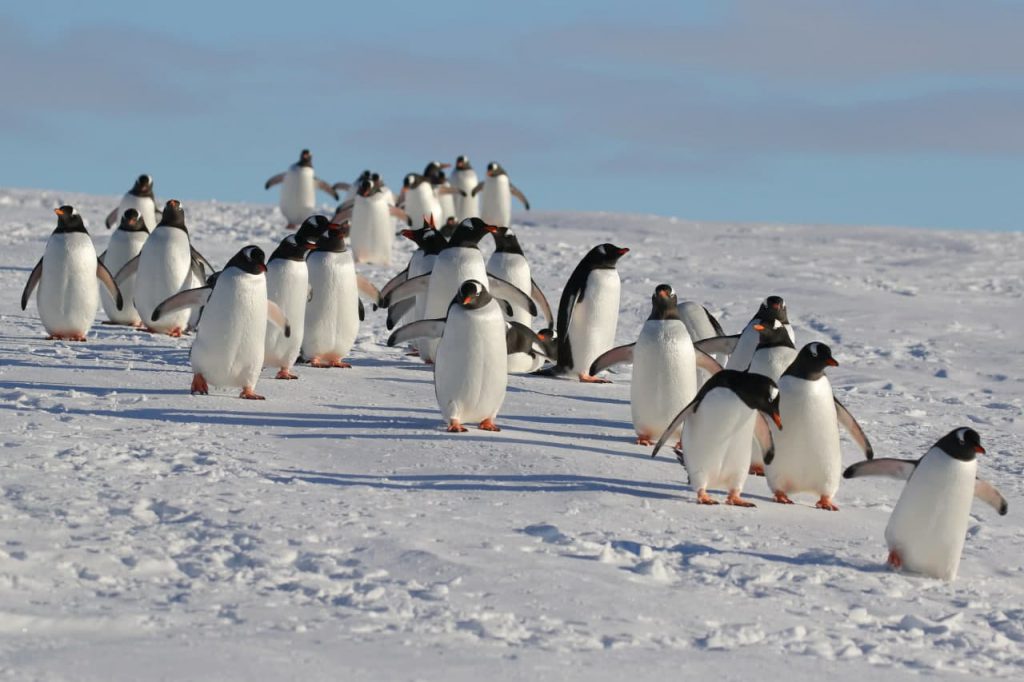
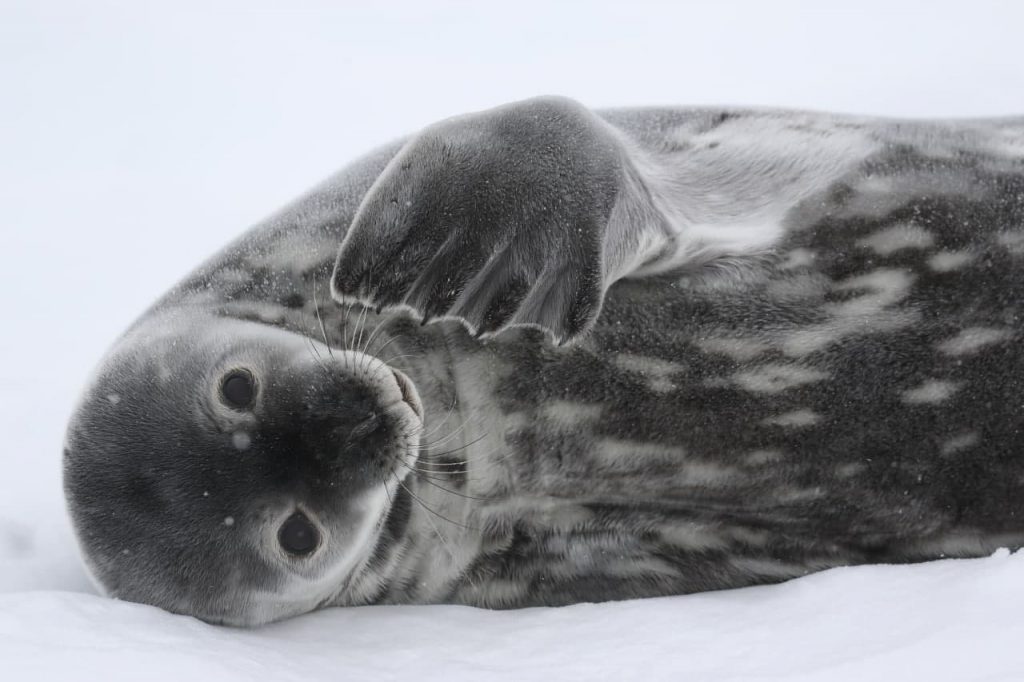
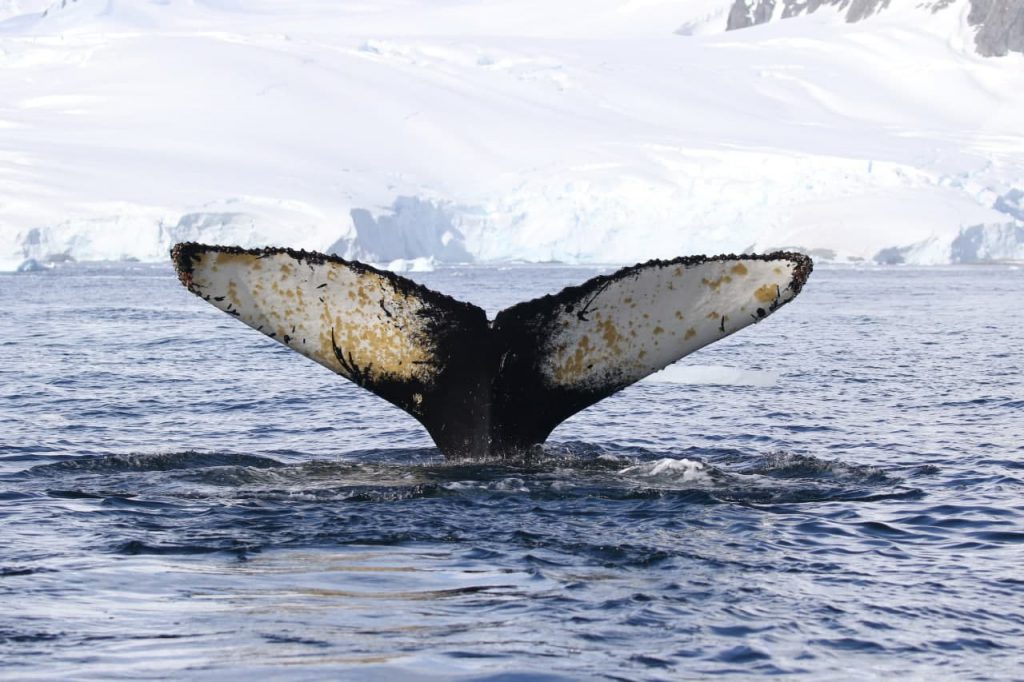
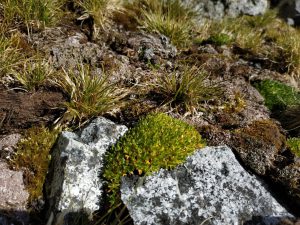
Антарктичні наземні екосистеми характеризуються низьким біорізноманіттям, вони обмежені в просторі льодовиками та сніговим покривом. Характерною рисою цих екосистем є вагомий вплив на їхнє функціонування прокаріот, криптогам та безхребетних тварин. Флора судинних рослин Антарктики представлена лише двома видами (Deschampsia antarctica та Colobanthus quitensis). Роль антарктичних наземних екосистем полягає в акумуляції органічної речовини та створенні умов для існування в найбільш екстремальних умовах на планеті. Флора району Аргентинських островів, де розташована станція “Академік Вернадський”, налічує 49 видів мохоподібних, 7 видів печіночників, 123 види лишайників. Крім того присутні численні водорості та гриби. Антарктичні екосистеми населяють нечисленні безхребетні тварини. Наземні екосистеми і їхні окремі складові є чутливими до змін клімату та антропогенного тиску, тому потребують постійного моніторингу та захисту.
Відділ біології та екології НАНЦ працює над кількома напрямами вивчення наземних екосистем Антарктики:
- регулярне вивчення стану популяцій судинних рослин Антарктики в межах району Аргентинских островів. Визначення популяційних показників рослин на моніторингових точках та пошук раніше не відомих локалітетів рослин;
- дослідження різноманіття мохоподібних, лишайників та інших складових екосистем регіону та визначення властивостей наземних угруповань, які можуть бути використані для моніторингу кліматичних змін, впливу пінгвінів та інших факторів;
- різноманіття та роль асоційованих з рослинами мікроорганізмів у адаптації антарктичних рослин до несприятливих умов існування. Вивчення зміни функціонування мікробіому наземних угруповань внаслідок орнітогенного впливу;
- окремим напрямом є вивчення історії походження та генетичної гетерогенності антарктичних безхребетних: двокрилих (Belgica antarctica), прісноводних ракоподібних (Boeckella poppei), ногохвісток та тихоходів.
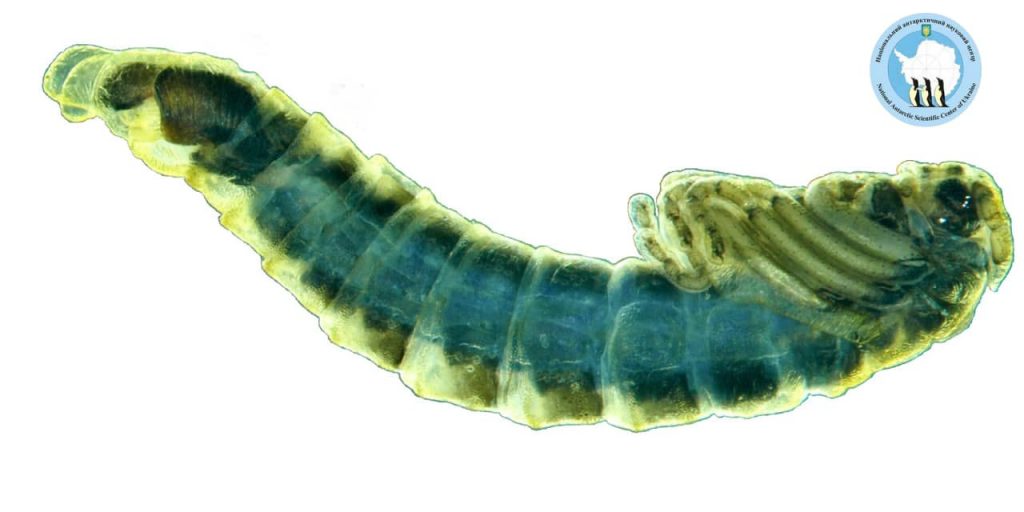
Лялечка Belgica antarctica Дослідження різноманіття представників мікроорганізмів, тваринного та рослинного світу наземних екосистем та механізми їхньої адаптації до суворих умов існування знаходяться у руслі програм “State of the Antarctic Ecosystem” and “Antarctic Thresholds – Ecosystem Resilience and Adaptation”.
Адаптація антарктичних організмів відбувається завдяки взаємодії різноманітних механізмів та продукції цілої низки біологічно активних речовин. Тому важливим є вивчення рослин, тварин та мікроорганізмів на предмет наявності речовин, цінних для біотехнології чи фармацевтичної галузі. Зокрема, ведеться вивчення цінних властивостей антарктичних мікроорганізмів та фенольних біологічно активних сполук антарктичних видів рослин. Для цього ведуться дослідження з введення в культуру та підтримки колекції антарктичних організмів, що дозволяє працювати з ними без залучення матеріалу безпосередньо з природних популяцій.
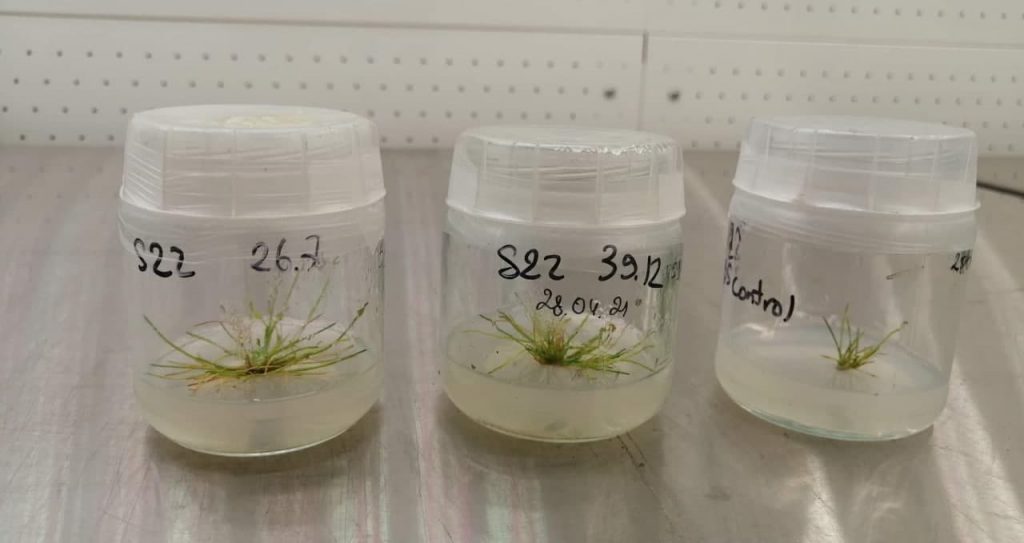
Механізмом збереження унікальних наземних екосистем Антарктики є запровадження та контроль регуляції потоку туристів в регіоні, зокрема, підготовка та корекція правил туристичного відвідування різних куточків Антарктики, зокрема регіону Аргентинських островів. Проводиться робота щодо створення територій з особливим статусом, а саме Antarctic Specially Protected Area (ASPA).
Зокрема, вивчаються популяції рідкісних видів флори України, ведуться дослідження різних складових адаптації організмів Чорного моря до глобальних впливів. Проводяться дослідження генетичних механізмів адаптації організмів до умов довкілля на модельному об’єкті Drosophila melanogaster.
Докладніше про відповідну наукову групу можна дізнатися тут.
Співпраця
Відділ екології і біології співпрацює з низкою наукових установ України: Інститутом молекулярної біології і генетики НАН України, Інститутом харчової біотехнології і геноміки НАН України, Національним ботанічним садом НАН України імені М. Гришка, Київським національним університетом імені Тараса Шевченка, Львівським національним університетом імені І. Франка та багатьма іншими. Ведеться співпраця також з науковими і природоохоронними інституціями Польщі, Німеччини, США, Литви, Туреччини, Малайзії, Словаччини, Чехії та інших країн.
2024
| Andrzejowska, A., Hájek, J., Puhovkin, A., Harańczyk, H., & Barták, M. (2024). Freezing temperature effects on photosystem II in Antarctic lichens evaluated by chlorophyll fluorescence. Journal of Plant Physiology, 296, 154192. https://doi.org/10.1016/j.jplph.2024.154192 |
| Iungin, O., Prekrasna-Kviatkovska, Y., Kalinichenko, O., Moshynets, O., Potters, G., Sidorenko, M., Savchuk, Y., & Mickevičius, S. (2024). Endophytic bacterial biofilm-formers associated with Antarctic vascular plants. Microorganisms, 12(10), 1938. https://doi.org/10.3390/microorganisms12101938 |
| Iungin, O., Prekrasna-Kviatkovska, Y., Kalinichenko, O., Savchuk, Y., Krainova, Y., Sidorenko, M., & Mickevičius, S. (2024). Antifungal activity of endophytic bacteria associated with Antarctic vascular plants. In Proceedings of the 10th International Conference on Advanced Materials and Systems (ICAMS 2024) (pp. 107–110). Bucharest: INCDTP. https://doi.org/10.2478/9788367405805-015 |
| Iungin, O., Prekrasna-Kviatkovska, Y., Kalinichenko, O., Savchuk, Y., Sidorenko, M., & Mickevičius, S. (2024). Biocontrol potential of Antarctic endophytic bacteria. Український антарктичний журнал, 2, 219–228. https://doi.org/10.33275/1727-7485.2.2024.738 |
| Krzewicka, B., Parnikoza, I., Ivanets, V., Yevchun, H., & Smykla, J. (2024). Diversity and distribution of the lichen genus Umbilicaria in the Argentine Islands–Kyiv Peninsula region, the maritime Antarctic. Scientific Reports, 14(1), Article 65806. https://doi.org/10.1038/s41598-024-65806-7 |
| Lohmann, R., Vrana, B., Muir, D., Smedes, F., Sobotka, J., Zeng, E. Y., Bao, L.-J., Allan, I. J., Astrahan, P., Bidleman, T., Crowley, D., Dykyi, E., Estoppey, N., Fillmann, G., Jantunen, L., Kaserzon, S., Maruya, K. A., McHugh, B., Newman, B., … Wong, C. S. (2024). AQUA-GAPS/MONET-derived concentrations and trends of PAHs and polycyclic musks across global waters. Environmental Science & Technology. Advance online publication. https://doi.org/10.1021/acs.est.4c03099 |
| Miryuta, N., Prekrasna-Kviatkovska, I., Myryuta, G., Poronnik, O., & Parnikoza, I. (2024). Rhizosphere bacterial community influence on Deschampsia antarctica É. Desv. adaptability in context of temperature near plants in local spatial scales of Galindez Island, Argentine Islands (the maritime Antarctic). Czech Polar Reports, 14(1), 45–59. https://doi.org/10.5817/cpr2024-1-6 |
| Mishra, K. B., Rosputinský, M., Grieš, M., & Puhovkin, A. (2024). Photoprotective mechanisms activated in Antarctic moss Chorisodontium aciphyllum during desiccation. Czech Polar Reports, 14(1), 1–14. https://doi.org/10.5817/cpr2024-1-1 |
| Prekrasna-Kviatkovska, Y., Parnikoza, I., Yerkhova, A., Stelmakh, O., Pavlovska, M., Dzyndra, M., Yarovyi, O., & Dykyi, E. (2024). From acidophilic to ornithogenic: Microbial community dynamics in moss banks altered by gentoo penguins. Frontiers in Microbiology, 15, 1362975. https://doi.org/10.3389/fmicb.2024.1362975 |
| Puhovkin, A., & Parnikoza, I. (2024). Do spectral reflectance indices distinguish between the greenness in three different moss species in moss banks on Galindez Island (Argentine Islands)? Czech Polar Reports, 14(1), 90–101. https://doi.org/10.5817/cpr2024-1-10 |
| Rubtsova, N. Y., Chaudhary, A., Glotov, S., & Kuzmina, T. A. (2024). Description of Pseudobenedeniella johnstoni sp. n. (Monogenea: Capsalidae) from the gills of Antarctic black rockcod, Notothenia coriiceps Richardson in coastal waters of West Antarctica. Helminthologia, 61(4), 327–344. https://doi.org/10.2478/helm-2024-0037 |
| Rybalko, S., Poronnik, O., Myryuta, G., Balanda, A., Arkhypova, M., Starosyla, D., Deryabin, O., Puhovkin, A., Parnikoza, I., & Kunakh, V. (2024). Antiviral activity of Deschampsia antarctica plant extracts in vitro. Czech Polar Reports, 14(2). https://doi.org/10.5817/CPR2023-2-18 |
2023
| A., Váczi, P., Puhovkin, A., Mishra, K. B., & Giordano, D. (2023). Resistance of primary photosynthesis to photoinhibition in Antarctic lichen Xanthoria elegans: Photoprotective mechanisms activated during a short period of high light stress. Plants, 12(12), 2259. https://doi.org/10.3390/plants12122259 |
| Andreev, I. O., Mel’nyk, V. M., Parnikoza, I. Yu., & Kunakh, V. A. (2023). Molecular organization and intragenomic variability of intergenic spacer of 5S rRNA genes in Colobanthus quitensis. Cytology and Genetics, 57(5), 399–405. https://doi.org/10.3103/S0095452723050018 |
| Barták, M., Hájek, J., Halıcı, M. G., Bednaříková, M., Casanova-Katny, |
| Ihtimanska, M. K., Kovalenko, P. A., Michailova, P. V., & Parnikoza, I. Yu. (2023). Larval morphology of Belgica antarctica Jacobs, 1900 (Diptera, Chironomidae, Orthocladiinae) from central part of the maritime Antarctic and deformities found in the larvae. Zootaxa, 5311(3), 405–416. https://doi.org/10.11646/zootaxa.5311.3.5 |
| Ivanets, V., Wierzgoń, M., Yevchun, H., & Parnikoza, I. (2023). Range extensions for moss species on the West Side of the Antarctic Peninsula. Cryptogamie, Bryologie, 44(2). https://doi.org/10.5252/cryptogamie-bryologie2023v44a2 |
| Komplikevych, S., Maslovska, O., Peretyatko, T., Moroz, O., Diakiv, S., Zaritska, Ye., Parnikoza, I., & Hnatush, S. (2023). Culturable microorganisms of substrates of terrestrial plant communities of the maritime Antarctic (Galindez Island, Booth Island). Polar Biology, 46(1), 1–19. https://doi.org/10.1007/s00300-022-03103-7 |
| Kotov, D., Richards, P. G., Reznychenko, M., Bogomaz, O., Truhlík, V., Nossal, S., Mierkiewicz, E., Zhivolup, T., Domnin, I., Miyoshi, Y., Tsuchiya, F., Kumamoto, A., Kasahara, Y., Kitahara, M., Nakamura, S., Matsuoka, A., Shinohara, I., & Hairston, M. (2023). Interhemispheric ionosphere–plasmasphere system shows a high sensitivity to the exospheric neutral hydrogen density: A caution of the global reference atmospheric model hydrogen density. Frontiers in Astronomy and Space Sciences, 10, 1113706. https://doi.org/10.3389/fspas.2023.1113706 |
| Lohmann, R., Vrana, B., Muir, D., Smedes, F., Sobotka, J., Zeng, E. Y., Bao, L.-J., Allan, I. J., Astrahan, P., Barra, R. O., Bidleman, T., Dykyi, E., Estoppey, N., Fillmann, G., Greenwood, N., Helm, P. A., Jantunen, L., Kaserzon, S., Macías, J. V., … Wong, C. S. (2023). Passive-sampler-derived PCB and OCP concentrations in the waters of the world─First results from the AQUAGAPS/MONET network. Environmental Science & Technology, 57(25), 9342–9352. https://doi.org/10.1021/acs.est.3c01866 |
| Pallin, L. J., Kellar, N. M., Steel, D., Botero-Acosta, N., Baker, C. S., Conroy, J. A., Costa, D. P., Johnson, C. M., Johnston, D. W., Nichols, R. C., Nowacek, D. P., Read, A. J., Savenko, O., Schofield, O. M., Stammerjohn, S. E., Steinberg, D. K., & Friedlaender, A. S. (2023). A surplus no more? Variation in krill availability impacts reproductive rates of Antarctic baleen whales. Global Change Biology, 29(8), 2108–2121. https://doi.org/10.1111/gcb.16559 |
| Polishchuk, A., Kayastha, P., Kovalenko, P., Parnikoza, I., & Kaczmarek, Ł. (2023). New records of tardigrades from the Danco and Graham Coasts, the maritime Antarctic. Annales Zoologici, 73(1). https://doi.org/10.3161/00034541ANZ2023.73.1.002 |
| Poronnik, O., Twardovska, M., Kunakh, V., Andreev, I., Drobyk, N., Navrotska, D., Nuzhyna, N., Konvalyuk, I., Myryuta, G., Ivannikov, R., & Parnikoza, I. (2023). Development, integrative study and research prospects of Deschampsia antarctica collection. Polish Polar Research, 44(1), 41–68. https://doi.org/10.24425/ppr.2023.144537 |
| Puhovkin, A., Hájek, J., Giordano, D., Sekerák, J., & Barták, M. (2023). Cryoresistance differences between species of autotrophs from polar regions sensed by chlorophyll fluorescence. Problems of Cryobiology and Cryomedicine, 33(1), 25–37. https://doi.org/10.15407/cryo33.01.025 |
| Puhovkin, A., Smykla, J., Váczi, P., & Parnikoza, I. (2023). Spectral characteristics of bryophyte carpet and mat subformation showing a vitality-dependent color pattern: Comparison for two distant regions of maritime Antarctica. Czech Polar Reports, 13(1). https://doi.org/10.5817/CPR2023-1-9 |
| Puhovkin, A., Smykla, J., Váczi, P., & Parnikoza, I. (2023). Spectral characteristics of bryophyte carpet and mat subformation showing a vitality-dependent color pattern: Comparison for two distant regions of maritime Antarctica. Czech Polar Reports, 13(1). https://doi.org/10.5817/CPR2023-1-9 |
| Serga, S., Maistrenko, O. M., Kovalenko, P. A., Tsila, O., Hrubiian, N., Bilokon, S., Alieksieieva, T., Radionov, D., Betancourt, A. J., & Kozeretska, I. (2023). Wolbachia in natural Drosophila simulans (Diptera: Drosophilidae) populations in Ukraine. Symbiosis, 91(2), 187–196. https://doi.org/10.1007/s13199-023-00899-8 |
| Sotnik, G., Spinova, Y., Sotnik, T., Polotska, O., Kysil, O., Krakovska, S., Diachuk, O., Bezvershenko, Y., Berezko, O., Beldavs, V., & Andrusevych, A. (2023). How to help Ukrainian scientists overcome Russia’s invasion and advance sustainability. Proceedings of the National Academy of Sciences, 120(6), e2219792120. https://doi.org/10.1073/pnas.2219792120 |
| Syrota, Y. Y., Kuzmin, Y. I., Lisitsyna, O. I., Salganskiy, O. O., Dykyy, I. V., Korol, E. M., du Preez, L. H., Dmytrieva, I. G., & Kuzmina, T. A. (2023). Infection patterns of helminth community in black rockcod Notothenia coriiceps in West Antarctica over a 6-year term. Parasitology Research, 122(3), 853–865. https://doi.org/10.1007/s00436-023-07785-8 |
| Wierzgoń, M., Ivanets, V., Prekrasna-Kviatkovska, Y., Plášek, V., & Parnikoza, I. (2023). Moss bank composition on Galindez Island (Argentine Islands, maritime Antarctic). Polar Biology, 46(11), 1235–1249. https://doi.org/10.1007/s00300-023-03197-7 |
2022
| Chattová, B., Zotov, A., & Parnikoza, I. (2022). Moss inhabiting diatoms of Galindez Island, Argentine Islands (the maritime Antarctica) exhibit low diversity and pronounced differentiation. Czech Polar Reports, 1, 60–77 |
| Faltýnková, A., Kudlai, O., Salganskiy, O. O., Korol, E. M., & Kuzmina, T. A. (2022). Trematodes from Antarctic teleost fishes off Argentine Islands, West Antarctica: Molecular and morphological data. Systematic Parasitology, 99(4), 491–523. https://doi.org/10.1007/s11230-022-10041-9 |
| González-Fernández D., Hanke G., Pogojeva M., Machitadze N., Kotelnikova Y., Tretiak I., Savenko O., et al. (2022). Floating marine macro litter in the Black Sea: Toward baselines for large scale assessment. Environmental Pollution, 306, 119816. https://doi.org/10.1016/j.envpol.2022.119816 |
| Gorb E.V., Kozeretska I.A., Gorb S.N. (2022). Hierarchical epicuticular wax coverage on leaves of Deschampsia antarctica as a possible adaptation to severe environmental conditions. Beilstein Journal of Nanotechnology, 13, 807–816. https://doi.org/10.3762/bjnano.13.71 |
| https://doi.org/10.5817/CPR2022-1-5 |
| Iungin, O., Prekrasna, I., Bortyanuy, I., Maslak, V., & Mickevičius, S. (2022). Plant growth-promoting characteristics of Antarctic endophytic bacteria. Proceedings of the 9th International Conference on Advanced Materials and Systems. https://doi.org/10.24264/icams-2022.II.11 |
| Ivanets, V., Yevchun, H., Miryuta, N., Veselsky, M., Salganskiy, O., Konishchuk, V., Kozeretska, I., Dykyi, E., & Parnikoza, I. (2022). Skua and plant dispersal: Lessons from the Argentine Islands – Kyiv Peninsula region in the maritime Antarctic. Nordic Journal of Botany, 40(6). https://doi.org/10.1111/njb.03326 |
| Ivannikov R., Anishchenko V., Kuzema P., Stavinskaya O., Laguta I., Poronnik O., Parnikoza I. (2022). Chromatographic and mass spectrometric analysis of secondary metabolites of Deschampsia antarctica from Galindez Island, Argentine Islands. Polish Polar Research, 43, 341–362. https://doi.org/10.24425/ppr.2022.140369 |
| Kondratiuk S.Y., Lőkös L., Kärnefelt I., Kondratiuk T.O., Parnikoza I.Yu., Yamamoto Y., Hur J.-S., Thell A. (2022). New and noteworthy lichen-forming and lichenicolous fungi, 12. Acta Botanica Hungarica, 64(3–4), 337–368. https://doi.org/10.1556/034.64.2022.3-4.8 |
| Kovalenko P., Serga S., Einor D., Gorobchyshyn V., Trokhymets V., Protsenko O., Kozeretska I. (2022). Unsupervised learning for detection of possible sexual dimorphism in larvae of Belgica antarctica Jacobs (Diptera, Chironomidae). Czech Polar Reports, 12(1), 1–14. https://doi.org/10.5817/CPR2022-1-1 |
| Kozeretska, I. (2022). We are being blacked out, but light is within us! Fly, 16(1), 1–3. https://doi.org/10.1080/19336934.2022.2162603 |
| Kuzmina, T. A., Vishnyakova, K. O., Lisitsyna, O. I., Korol, E. M., & Kuzmin, Y. I. (2022). Helminth diversity in teleost fishes from the South Orkney Islands region, West Antarctica. Zooriznomanittia (Visnyk Zoologii), 2, 135–152. https://doi.org/10.15407/zoo2022.02.135 |
| Pallin L., Bierlich K.C., Durban J., Fearnbach H., Savenko O., Baker C.S., et al. (2022). Demography of an ice-obligate mysticete in a region of rapid environmental change. Royal Society Open Science, 9, 220724. https://doi.org/10.1098/rsos.220724 |
| Pallin L.J., Botero-Acosta N., Steel D., Baker C.S., Casey C., Costa D.P., et al. (2022). Variation in blubber cortisol levels in a recovering humpback whale population inhabiting a rapidly changing environment. Scientific Reports, 12, 24704. https://doi.org/10.1038/s41598-022-24704-6 |
| Prekrasna I., Pavlovska M., Oleinik Y., Dykyi E., Slobodnik J., Alygizakis N., Solomenko L., Stoica E. (2022). Bacterial communities of the Black Sea exhibit activity against persistent organic pollutants in the water column and sediments. Ecotoxicology and Environmental Safety, 241, 113367. https://doi.org/10.1016/j.ecoenv.2022.113367 |
| Puhovkin, A., Bezsmertna, O., & Parnikoza, I. (2022). Interspecific differences in desiccation tolerance of selected Antarctic lichens: Analysis of photosystem II effectivity and quenching mechanisms. Czech Polar Reports, 1, 31–43 https://doi.org/10.5817/CPR2022-1-3 |
| Rozwalak P., Podkowa P., Buda J., Niedzielski P., Kawecki S., Ambrosini R., Azzoni R.S., Baccolo G., Ceballos J.L., Cook J., Di Mauro B., Ficetola G.F., Franzetti A., Ignatiuk D., Klimaszyk P., Łokas E., Ono M., Parnikoza I., Pietryka M., Pittino F., Poniecka E., Porazinska D.L., Richter D., Schmidt S.K., Sommers P., Souza-Kasprzyk J., Stibal M., Szczuciński W., Uetake J., Wejnerowski Ł., Yde J.C., Takeuchi N., Zawierucha K. (2022). Cryoconite – From minerals and organic matter to bioengineered sediments on glacier’s surfaces. Science of The Total Environment, 807, 150874. https://doi.org/10.1016/j.scitotenv.2021.150874 |
| Savenko, O. (2022). Winter records of killer whales (Orcinus orca) in the waters of the Wilhelm Archipelago, West Antarctica. Theriologia Ukrainica, 24, 210–215. https://doi.org/10.15407/tu2417 |
| Savenko, O., & Friedlaender, A. (2022). New sightings of the Southern right whales in West Antarctic Peninsula waters. Ukrainian Antarctic Journal, 20(1(24), 104-112. https://doi.org/10.33275/1727-7485.1.2022.693 |
| Trokhymets V., Savytskiy O., Zinkovskyi A., Gupalo O., Dykyy I., Lutsenko D., Berezkina A., La Mesa M. (2022). Species composition, distribution and relative abundance of the inshore fish community off the Argentine Islands, Bellingshausen Sea. Polar Biology, 45, 845–855. https://doi.org/10.1007/s00300-022-03040-5 |
| Van der Linde K., Visser I.N., Bout R., Krause D.J., Forcada J., Siniff D., et al. (2022). A review of leopard seal (Hydrurga leptonyx) births and pups using a standardised age-class classification system. Polar Biology, 45, 1193–1209. https://doi.org/10.1007/s00300-022-03053-0 |
| Yerkhova, A., Parnikoza, I., Pavlovska, M., Yevchun, H., & Prekrasna-Kviatkovska, Y. (2022). Microbiomes of Antarctic pearlwort (Colobanthus quitensis) of the maritime Antarctic: distinct diversity and core microbes in rhizosphere and endosphere compartments of the plant. Ukrainian Antarctic Journal, 20(2(25), 212-240. https://doi.org/10.33275/1727-7485.2.2022.701 |
| Yerkhova A., Parnikoza I., Pavlovska M., Yevchun H., Prekrasna-Kviatkovska Y. (2022). Microbiomes of Antarctic pearlwort (Colobanthus quitensis) of the maritime Antarctic: distinct diversity and core microbes in rhizosphere and endosphere compartments of the plant. Український антарктичний журнал, 2, 61–82. https://doi.org/10.33275/1727-7485.2.2022.701 |
2021
| Abakumov, E. V., Parnikoza, I. Yu., Zhianski, M., Yaneva, R., Lupachev, A. V., Andreev, M. P., Vlasov, D. Yu., Riano, J., & Jaramillo, N. (2021). Ornithogenic factor of soil formation in Antarctica: A review. Eurasian Soil Science, 54(4), 528–540. https://doi.org/10.1134/S106422932104025X |
| Andreev I.O., Parnikoza I.Yu., Konvalyuk I.I., Metcheva R., Kozeretska I.A., Kunakh V.A. (2021). Genetic divergence of Deschampsia antarctica (Poaceae) population groups in the maritime Antarctic. Biological Journal of the Linnean Society, 134(2), 223–234. https://doi.org/10.1093/biolinnean/blab141 |
| Bublyk, O., Parnikoza, I. & Kunakh, V. Assessing the Levels of Polymorphism and Differentiation in Iris pumila L. Populations Using Three Types of PCR Markers. Cytol. Genet. 55, 36–46 (2021). https://doi.org/10.3103/S0095452721010047 |
| González-Fernández, D., Cózar, A., Hanke, G., Viejo, J., Morales-Caselles, C., Bakiu, R., Barceló, D., Bessa, F., Bruge, A., Cabrera, M., Castro-Jiménez, J., Constant, M., Crosti, R., Galletti, Y., Kideys, A. E., Machitadze, N., Pereira de Brito, J., Pogojeva, M., Ratola, N., Rigueira, J., … Tourgeli, M. (2021). Floating macrolitter leaked from Europe into the ocean. Nature Sustainability, 4(6), 474–483. https://doi.org/10.1038/s41893-021-00722-6 |
| Gromyko, O., Tistechok, S., Roman, I., Aravitska, O., Luzhetskyy, A., Parnikoza, I., & Fedorenko, V. (2021). Isolation and characterization of culturable actinobacteria associated with Polytrichum strictum (Galindez Island, the maritime Antarctic). Ukrainian Antarctic Journal, (1), 82-97. https://doi.org/10.33275/1727-7485.1.2021.668 |
| Hnatush, S., Komplikevych, S., Maslovska, O., Moroz, O., Peretyatko, T., Dzhulai, A., & Krasnozhon, T. (2021). Bacteria of the genus Pseudomonas isolated from Antarctic substrates. Ukrainian Antarctic Journal, (2), 58-75. https://doi.org/10.33275/1727-7485.2.2021.678 |
| Ivannikov, R., Laguta, I., Anishchenko, V., Skorochod, I., Kuzema, P., Stavinskaya, O., Parnikoza, I., Poronnik, O., Myryuta, G., & Kunakh, V. (2021). Composition and radical scavenging activity of the extracts from Deschampsia antarctica É. Desv. plants grown in situ and in vitro. Chemistry Journal of Moldova, 16(1), 105–114. https://doi.org/10.19261/cjm.2021.841 |
| Kapun, M., Nunez, J. C. B., Bogaerts-Márquez, M., Murga-Moreno, J., Paris, M., Outten, J., Coronado-Zamora, M., Tern, C., Rota-Stabelli, O., Guerreiro, M. P. G., Casillas, S., Orengo, D. J., Puerma, E., Kankare, M., Ometto, L., Loeschcke, V., Onder, B. S., Abbott, J. K., Schaeffer, S. W., Rajpurohit, S., … Bergland, A. O. (2021). Drosophila evolution over space and time (DEST): A new population genomics resource. Molecular Biology and Evolution, 38(12), 5782–5805. https://doi.org/10.1093/molbev/msab259 |
| Korczak-Abshire, M., Hinke, J. T., Milinevsky, G., Juáres, M. A., & Watters, G. M. (2021). Coastal regions of the northern Antarctic Peninsula are key for gentoo populations. Biology Letters, 17(1), 20200708. https://doi.org/10.1098/rsbl.2020.0708 |
| Kovalenko, P., Trokhymets, V., Parnikoza, I., Protsenko, Y., Salganskiy, O., Dzhulai, A., Dykyy, I., Nabokin, M., Kozeretska, I., & Gorobchyshyn, V. (2021). Current status of Belgica antarctica Jacobs, 1900 (Diptera: Chironomidae) distribution by the data of Ukrainian Antarctic Expeditions. Ukrainian Antarctic Journal, (2), 76-93. https://doi.org/10.33275/1727-7485.2.2021.679 |
| Kozeretska, I., Serga, S., Kovalenko, P., Gorobchyshyn, V., Convey, P. (2021). Belgica antarctica (Diptera: Chironomidae): A natural model organism for extreme environments. Insect Science, 0, 1-19. https://doi.org/10.1111/1744-7917.12925 |
| Kuzmina, T. A., Dykyy, I. V., Salganskij, O. O., Lisitsyna, O. I., Korol, E. M., & Kuzmin, Y. I. (2021). Helminth diversity in teleost fishes from the area of the Ukrainian Antarctic Station “Akademik Vernadsky”, Argentine Islands, West Antarctica. Zooriznomanittya (Visnyk Zoolohii), 3, 251–264. https://doi.org/10.15407/zoo2021.03.251 |
| Kuzmina, T. A., Laskowski, Z., Salganskij, O. O., Zdzitowiecki, K., Lisitsyna, O. I., & Kuzmin, Y. (2021). Helminth assemblages of the Antarctic black rockcod, Notothenia coriiceps (Actinopterygii: Nototheniidae) in coastal waters near Galindez Island (Argentine Islands, West Antarctic): Temporal changes in the endoparasite community. Acta Parasitologica, 66(1), 207–217. https://doi.org/10.1007/s11686-021-00448-7 |
| Kuzmina, T. A., Salganskij, O. O., Dykyy, I. V., Lisitsyna, O. I., Korol, E. M., Faltýnková, A., & Kuzmin, Y. I. (2021). Helminths of the Antarctic dragonfish, Parachaenichthys charcoti (Perciformes, Notothenioidei, Bathydraconidae) studied near Galindez Island (Argentine Islands, West Antarctica). Acta Parasitologica, 66(4), 1424–1430. https://doi.org/10.1007/s11686-021-00417-0 |
| Machado, H. E., Bergland, A. O., Taylor, R., Tilk, S., Behrman, E., Dyer, K., Fabian, D. K., Flatt, T., González, J., Karasov, T. L., Kim, B., Kozeretska, I., Lazzaro, B. P., Merritt, T. J. S., Pool, J. E., O’Brien, K., Rajpurohit, S., Roy, P. R., Schaeffer, S. W., Serga, S., … Petrov, D. A. (2021). Broad geographic sampling reveals the shared basis and environmental correlates of seasonal adaptation in Drosophila. eLife, 10, e67577. https://doi.org/10.7554/eLife.67577 |
| Marcondes, M. C. C., Cheeseman, T., Jackson, J. A., Friedlaender, A. S., Pallin, L., Olio, M., Wedekin, L. L., Daura-Jorge, F. G., Cardoso, J., Santos, J. D. F., Fortes, R. C., Araújo, M. F., Bassoi, M., Beaver, V., Bombosch, A., Clark, C. W., Denkinger, J., Boyle, A., Rasmussen, K., … Sousa-Lima, R. S. (2021). The Southern Ocean Exchange: Porous boundaries between humpback whale breeding populations in southern polar waters. Scientific Reports, 11, Article 2612. https://doi.org/10.1038/s41598-021-02612-5 |
| Michailova, P., Ilkova, J., Kovalenko, P., Dzhulai, A., Kozeretska, I. (2021) Long-term retainment of some chromosomal inversions in a local population of Belgica antarctica Jacobs (Diptera, Chironomidae). Czech Polar Reports, 11(1), 16-24. https://doi.org/10.5817/CPR2021-1-3 |
| Michailova, P., Ilkova, J., Kovalenko, P.A., Gorobchyshyn, V.A., Kozeretska, I.A., Convey, P. (2021). External Morphology of Larvae of Belgica antarctica Jacobs, 1900 (Diptera, Chironomidae) Obtained from Two Locations in Maritime Antarctica. Insects, 12(9), 792. https://doi.org/10.3390/insects12090792 |
| Mioduchowska, M., Kačarević, U., Miamin, V., Giginiak, Y., Parnikoza, I., Roszkowska, M. & Kaczmarek, Ł. (2021). Redescription of Antarctic eutardigrade Dastychius improvisus (Dastych, 1984) and some remarks on phylogenetic relationships within Isohypsibioidea. European Zoological Journal, 88(Kozeretska1), 117-131. https://doi.org/10.1080/24750263.2020.1854877 |
| Miryuta, N., Parnikoza, I., Poronnik, O., Myryuta, G., Rojek-Jelonek, M., Dykyi, E., & Kunakh, V. (2021). Calculation of United Quality Latent Indices of Deschampsia antarctica plants adaptability of different origin grown in vitro. Ukrainian Antarctic Journal, (1), 56-81. https://doi.org/10.33275/1727-7485.1.2021.667 |
| Pavlovska, M., Prekrasna, I., Dykyi, E., Zotov, A., Dzhulai, A., Frolova, A., Slobodnik, J. & Stoica, E. (2021). Niche partitioning of bacterial communities along the stratified water column in the Black Sea. MicrobiologyOpen, 10(3), e1195. https://doi.org/10.1002/mbo3.1195 |
| Pavlovska M, Prekrasna I, Parnikoza I, Dykyi E. Soil Sample Preservation Strategy Affects the Microbial Community Structure. Microbes and Environments, Vol. 36 (2021) No. 1 ME20134 https://doi.org/10.1264/jsme2.ME20134 |
| Podolich, O., Prekrasna, Ie., Parnikoza, I., Voznyuk, T., Zubova, G., Zaets, I., Miryuta, N., Myryuta, G., Poronnik, O., Kozeretska, I., Kunakh, V., Pirttila, A.M., Dykyi, E., & Kozyrovska, N. (2021). First record of the endophytic bacteria of Deschampsia antarctica Ė. Desv. from two distant localities of the maritime Antarctic. Czech Polar Reports, 11(1), 134-153. https://doi.org/10.5817/CPR2021-1-10 |
| Serga, S. V., Maistrenko, O. M., Matiytsiv, N. P., Vaiserman, A. M., & Kozeretska, I. A. (2021). Effects of Wolbachia infection on fitness-related traits in Drosophila melanogaster. Symbiosis, 84(2), 163–172. https://doi.org/10.1007/s13199-020-00743-3 |
| Tistechok, S., Skvortsova, M., Mytsyk, Y., Fedorenko, V., Parnikoza, I., Luzhetskyy, A., & Gromyko, O. (2021). The diversity and antibacterial activity of culturable actinobacteria isolated from the rhizosphere soil of Deschampsia antarctica (Galindez Island, Maritime Antarctic). Polar Biology, 44(9), 1859–1868. https://doi.org/10.1007/s00300-021-02924-2 |
| Trokhymets, V., Gorobchyshyn, V., & Kozeretska, I. (2021). Population features of Boeckella poppei in Lake Wujka, King George Island. Ukrainian Antarctic Journal, (1), 117-122. https://doi.org/10.33275/1727-7485.1.2021.670 |
| Twardovska, M., Konvalyuk, I., Lystvan, K., Andreev, I., Parnikoza, I., & Kunakh, V. (2021). Phenolic and flavonoid contents in Deschampsia antarctica plants growing in nature and cultured in vitro. Polish Polar Research, 42, 97–116. https://doi.org/10.24425/ppr.2021.136602 |
| Utevsky, A., Solod, R., & Utevsky, S. (2021). A new deep-sea fish leech of the bipolar genus Pterobdellina stat. rev. (Hirudinea: Piscicolidae) parasitic on the Antarctic toothfish Dissostichus mawsoni (Perciformes: Nototheniidae). Marine Biodiversity, 51(1), 1–10. https://doi.org/10.1007/s12526-020-01140-1 |
| Wallace, M. A., Coffman, K. A., Gilbert, C., Ravindran, S., Albery, G. F., Abbott, J., Argyridou, E., Bellosta, P., Betancourt, A. J., Colinet, H., Eric, K., Glaser-Schmitt, A., Grath, S., Jelic, M., Kankare, M., Kozeretska, I., Loeschcke, V., Montchamp-Moreau, C., Ometto, L., … Obbard, D. J. (2021). The discovery, distribution, and diversity of DNA viruses associated with Drosophila melanogaster in Europe. Virus Evolution, 7(1), veab031. https://doi.org/10.1093/ve/veab031 |
| Yevchun, H., Dykyi, E., Kozeretska, I., Fedchuk, A., Karamushka, V., & Parnikoza, I. (2021). Minimizing tourist impact on the Argentine Islands ecosystem, Antarctic Peninsula, using visitor site guidelines approach. Ukrainian Antarctic Journal, (1), 98-116. https://doi.org/10.33275/1727-7485.1.2021.669 |
| Yevchun, H., Fedchuk, A., Drohushevska, I., Pnyovska, O., Chernyshenko, M., & Parnikoza, I. (2021). The Toponymy of the Argentine Islands area, the Kyiv Peninsula (West Antarctica). Ukrainian Antarctic Journal, (2), 127-157. https://doi.org/10.33275/1727-7485.2.2021.683 |
| Zabara, D., Kozeretska, I., Deineko, I., Anoshko, Y., Shapovalenko, N., Stamboli, L., & Dons’koi, B. (2021). Immune factors and health of Antarctic explorers. Ukrainian Antarctic Journal, (2), 94-105. https://doi.org/10.33275/1727-7485.2.2021.680 |
2020
| Avdiyuk, K. V., Varbanets, L. D., Berezkina, A. E., & Utevsky, A. Yu. (2020). Keratinolytic activity of Antarctic bacterial strains. Mikrobiolohichnyi Zhurnal, 82(2), 14–21. https://doi.org/10.15407/microbiolj82.02.014 |
| Bedernichek, T., Dykyy, I., Partyka, T., & Zaimenko, N. (2020). Why WRB needs a mammalic qualifier: The case of seal colony soils. Geoderma, 373, 114369. https://doi.org/10.1016/j.geoderma.2020.114369 |
| Bedernichek, T., Loya, V., & Parnikoza, I. (2020). Content of biogenic and toxic elements in the leaves of Deschampsia antarctica É. Desv. (Poaceae): a preliminary study. Plant Introduction, 85/86, 124-129. https://doi.org/10.46341/PI2020017 |
| Bublyk, O., Andreev, I., Parnikoza, I., & Kunakh, V. (2020). Population genetic structure of Iris pumila L. in Ukraine: effects of habitat fragmentation. Acta Biologica Cracoviensia Series Botanica, 62(1), 51–61. https://doi.org/10.24425/abcsb.2020.131665 |
| Daria Grobys, Milena Roszkowska, Magdalena Gawlak, Hanna Kmita, Andrzej Kepel, Marta Kepel, Ivan Parnikoza, Tomasz Bartylak, Łukasz Kaczmarek, High diversity in the Pseudechiniscus suillus–facettalis complex (Heterotardigrada: Echiniscidae) with remarks on the morphology of the genus Pseudechiniscus, Zoological Journal of the Linnean Society, Volume 188, Issue 3, March 2020, Pages 733–752, https://doi.org/10.1093/zoolinnean/zlz171 |
| Ellis, L. T., Afonina, O. M., Czernyadjeva, I. V., Konoreva, L. A., Potemkin, A. D., Kotkova, V. M., … Graulich, A. (2020). New national and regional bryophyte records, 63. Journal of Bryology, 42(3), 281–296. https://doi.org/10.1080/03736687.2020.1750930 |
| Gora, N.V., Serga, S.V., Maistrenko, O.M. et al. Climate Factors and Wolbachia Infection Frequencies in Natural Populations of Drosophila melanogaster. Cytol. Genet. 54, 189–198 (2020). https://doi.org/10.3103/S0095452720030044 |
| Gora, N.V., Serga, S.V., Maistrenko, O.M., Ślęzak-Parnikoza, A., Parnikoza I.Yu., Tarasiuk, A.N., Demydov, S.V., & Kozeretska, I.A. (2020). Climate Factors and Wolbachia Infection Frequencies in Natural Populations of Drosophila melanogaster. Cytology and Genetics, 54(3), 189-198. https://cytgen.com/en/2020/_16-27N3V54.htm (in Ukrainian) |
| Ishchenko, O. O., Mel’nyk, V. M., Parnikoza, I. Y., Budzhak, V. V., Panchuk, I. I., Kunakh, V. A., & Volkov, R. A. (2020). Molecular organization of 5S ribosomal DNA and taxonomic status of Avenella flexuosa (L.) Drejer (Poaceae). Cytology and Genetics, 54(6), 505–513. https://doi.org/10.3103/S0095452720060055 |
| Kaczmarek, Ł., Mioduchowska, M., Kačarević, U., Kubska, K., Parnikoza, I., Gołdyn, B., & Roszkowska, M. (2020). New Records of Antarctic Tardigrada with Comments on Interpopulation Variability of the Paramacrobiotus fairbanksi Schill, Förster, Dandekar and Wolf, 2010. Diversity, 12(3), 108. https://doi.org/10.3390/d12030108 |
| Kondratiuk, T.O., Beregova, T.V., Parnikoza, I.Yu., Kondratyuk, S.Y. & Thell, A. (2020). Microscopic fungi of lithobiont communities of Argentine Islands region: data from the 22nd Ukrainian Antarctic Expedition. Acta Botanica Hungarica, 62(1–2), 49–68. https://doi.org/10.1556/034.62.2020.1-2.5 |
| Kondratyuk, S.Y., Lokös, L., Oh, S.-O., Kondratyuk, T.O., Parnikoza, I.Yu., & Hur, J.-S. (2020). New and noteworthy lichen-forming and lichenicolous fungi, 11. Acta Botanica Hungarica, 62(3–4), 225–291. https://doi.org/10.1556/034.62.2020.3-4.3 |
| Kuzmina, T. A., Salganskij, O. O., Lisitsyna, O. I., & Korol, E. M. (2020). Helminths of Antarctic rockcod Notothenia coriiceps (Perciformes, Nototheniidae) from the Akademik Vernadsky station area (Argentine Islands, West Antarctica): New data on the parasite community. Zooriznomanittia (The Bulletin of Zoology), 55(2), 99–110. https://doi.org/10.15407/zoo2020.02.099 |
| Mariychuk, R. ., Kozeretska, I. ., Serga, S. ., Manko, P., & Obona, J. (2020). Current state of invasion of Drosophila suzukii (Matsumura, 1931) in Ukraine. European Journal of Ecology, 6(1), 51-57. https://doi.org/10.17161/eurojecol.v6i1.13675 |
| Martin Kapun, Maite G Barrón, Fabian Staubach, Darren J Obbard, R Axel W Wiberg, Jorge Vieira, Clément Goubert, Omar Rota-Stabelli, Maaria Kankare, María Bogaerts-Márquez, Annabelle Haudry, Lena Waidele, Iryna Kozeretska, Elena G Pasyukova, Volker Loeschcke, Marta Pascual, Cristina P Vieira, Svitlana Serga, Catherine Montchamp-Moreau, Jessica Abbott, Patricia Gibert, Damiano Porcelli, Nico Posnien, Alejandro Sánchez-Gracia, Sonja Grath, Élio Sucena, Alan O Bergland, Maria Pilar Garcia Guerreiro, Banu Sebnem Onder, Eliza Argyridou, Lain Guio, Mads Fristrup Schou, Bart Deplancke, Cristina Vieira, Michael G Ritchie, Bas J Zwaan, Eran Tauber, Dorcas J Orengo, Eva Puerma, Montserrat Aguadé, Paul Schmidt, John Parsch, Andrea J Betancourt, Thomas Flatt, Josefa González, Genomic Analysis of European Drosophila melanogaster Populations Reveals Longitudinal Structure, Continent-Wide Selection, and Previously Unknown DNA Viruses, Molecular Biology and Evolution, Volume 37, Issue 9, September 2020, Pages 2661–2678, https://doi.org/10.1093/molbev/msaa120 |
| Mykhailenko, A., Utevsky, A., Solodiankin, O., Zlenko, O., Maiboroda, O., Bolotin, V., Blaxland, J., & Gerilovych, A. (2020). First record of Serratia marcescens from Adélie and Gentoo penguin faeces collected in the Wilhelm Archipelago, Graham Land, West Antarctica. Polar Biology, 43(7), 903–910. https://doi.org/10.1007/s00300-020-02682-7 |
| Rabokon, A., Postovoitova, A., Bilonozhko, Yu., Kalafat, L., Pavlovska, M., Prekrasna, I., Parnikoza, I., Kozeretska, I., Pirko, Ya., & Blume, Ya. (2020). Assessment of Colobanthus quitensis genetic polymorphism from the Argentine Islands region (maritime Antarctic) by actin, α- and γ-tubulin genes intron analysis. Ukrainian Antarctic Journal, 1, 93–101. https://doi.org/10.33275/1727-7485.1.2020.382 |
| Roszkowska, M., Grobys, D., Bartylak, T., Gawlak, M., Kmita, H., Kepel, A., Kepel, M., Parnikoza, I. & Kaczmarek, Ł. (2020). Integrative description of five Pseudechiniscus species (Heterotardigrada: Echiniscidae: the suillus-facettalis complex). Zootaxa, 4763(4), 451–484. https://doi.org/10.11646/zootaxa.4763.4.1 |
| Shylo, O., Lutsenko, D., Lutsenko, O., Babiychuk, G., & Moiseyenko, Y. (2020). Sleep in Antarctica: From the sleep disturbances towards all the challenges. Problems of Cryobiology and Cryomedicine, 30(1), 3–23. https://doi.org/10.15407/cryo30.01.003 |
| Ustach, V. I., & Shuleiko, V. V. (2020). Recent distribution of Eurytemora velox (Lilljeborg, 1853) (Copepoda, Calanoida) in brackish and fresh waters of Ukraine. Crustaceana, 93(3–5), 275–281. https://doi.org/10.1163/15685403-00003992 |
| Varbanets, L. D., Berezkina, A. E., Avdiuk, E. V., Gudzenko, A. V., Bulygina, T. V., Kharkhota, M. A., & Utevsky, A. Yu. (2020). Keratinolytic and α-L-rhamnosidase activity of bacterial isolates, isolated from gastropod molluscs Nacella concinna (Nacellidae) − residents of Antarctic. Mikrobiolohichnyi Zhurnal, 82(1), 13–21. https://doi.org/10.15407/microbiolj82.01.013 |
| Zawierucha, K., Porazinska, D.L., Ficetola G.F., Ambrosini, R., Baccolo, G., Buda, J., Ceballos, J.L., Devetter, M., Dial, R., Franzetti, A., Fuglewicz, U., Gielly, L., Łokas, E., Janko, K., Novotna Jaromerska, T., Koscinski, A., Kozłowska, A., Ono, M., Parnikoza, I., Pittino, F., Poniecka, E., Sommers, P., Schmidt, S.K., Shain, D., Sikorska, S., Uetake, J., & Takeuchi, N. (2020). A hole in the nematosphere: tardigrades and rotifers dominate the cryoconite hole environment, whereas nematodes are missing. Journal of Zoology, 1, 18-36. https://doi.org/10.1111/jzo.12832 |
| Zhang, Y., Pavlovska, M., Stoica, E., Prekrasna, I., Yang, J., Slobodnik, J., Zhang, X., & Dykyi, E. (2020). Holistic pelagic biodiversity monitoring of the Black Sea via eDNA metabarcoding approach: From bacteria to marine mammals. Environment International, 135, 105307. https://doi.org/10.1016/j.envint.2019.105307 |
| Козерецька І.А., Корсун С.Г., Парнікоза І.Ю. / Kozeretska I., Korsun S., Parnikoza I. Патент на корисну модель №139545: Спосіб визначення фонового вмісту важких металів у ґрунтах островів Морської Антарктики / Utility model patent №139545: Method for determining the background content of trace elements in the soils of the islands of the maritime Antarctic. Зареєстровано в Державному реєстрі патентів України на корисні моделі 10.01.2020 р. |
2019
| Miryuta, N.Yu., Smykla, J., Parnikoza, I.Yu. (2019). Algorithm for the United Quality Latent Index of the plant adaptability and its application field in monitoring of Deschampsia antarctica È. Desv. populations. Ukrainian Antarctic Journal, 1(18), 152-168. http://uaj.uac.gov.ua/index.php/uaj/article/view/139/87 |
| Nuzhyna, N., Parnikoza, I., Poronnik, O., Kozeretska, I., & Kunakh, V. (2019). Anatomical variations of Deschampsia antarctica É. Desv. plants from distant Antarctic regions, in vitro culture, and in relations to Deschampsia caespitosa (L.) P. Beauv. Polish Polar Research, 40(4), 361–383. https://doi.org/10.24425/ppr.2019.130903 |
| Parnikoza, I. Yu., & Kozeretska, I. (2019). Antarctic Terrestrial Biome — Most Poor, Extreme and Sensitive on the Planet. In M. I. Goldstein, & D. A. DellaSala (Eds.), Encyclopedia of biomes, 2 (pp. 606-622). Elsevier. https://doi.org/10.1016/B978-0-12-409548-9.12005-6 |
| Parnikoza, I.Yu., Miryuta, N.Yu., Ivanets, V.Yu., & Dykyi E.O. (2019). Determination of the united quality latent index of adaptability (UQLIA) and contribution of some environmental parameters to it for Deschampsia antarctica populations, Galindez Island (maritime Antarctic) season 2017/2018. The Bulletin of Ukrainian Society of Gentetics and Breeders, 16(2), 190-202. https://doi.org/10.7124/visnyk.utgis.16.2.1057 (in Ukrainian) |
| Tistechok, S., Skvortsova, M., Luzhetskyy, A., Fedorenko, V., Parnikoza, I., & Gromyko, O. (2019). Antagonistic and Plant Growth Promoting Properties of Actinomycetes from Rhizosphere Deschampsia antarctica É. Desv. (Galindez Island, Antarctica). Ukrainian Antarctic Journal, 1(18), 169—177. http://uaj.uac.gov.ua/index.php/uaj/article/view/140/88 |
2018
| Parnikoza, I., Berezkina, А., Moiseyenko, Y., Malanchuk, V., & Kunakh, V. (2018). Complex survey of the Argentine Islands and Galindez Island (maritime Antarctic) as a research area for studying the dynamics of terrestrial vegetation. Ukrainian Antarctic Journal, 1(17), 73-101. (in Ukrainian) http://uaj.uac.gov.ua/index.php/uaj/article/view/34 (in Ukrainian) |
Наукові проекти
- Exploring the interplay of Antarctic bacterioplankton and phytoplankton by integration of biodiversity, contextual, and OMICS data. У співпраці з Німеччиною (Max Planck Institute for Marine Microbiology, Germany);
- Exploring beneficial role of endophytic bacteria for survival of Deschampsia antarctica in arid Antarctic environments using culture based and OMICS-techniques. У співпраці з Фінляндією (University of Oulu, Finland);
- Проєкт з вивчення популяції субантарктичних пінгвінів за допомогою системи камер за протоколами CEMP;
- Наземні біоценози в умовах глобальних змін у різних кліматичних зонах Антарктики (Terrestrial ecosystems under the influence of global changes in two different climatic zones of Antarctica).

